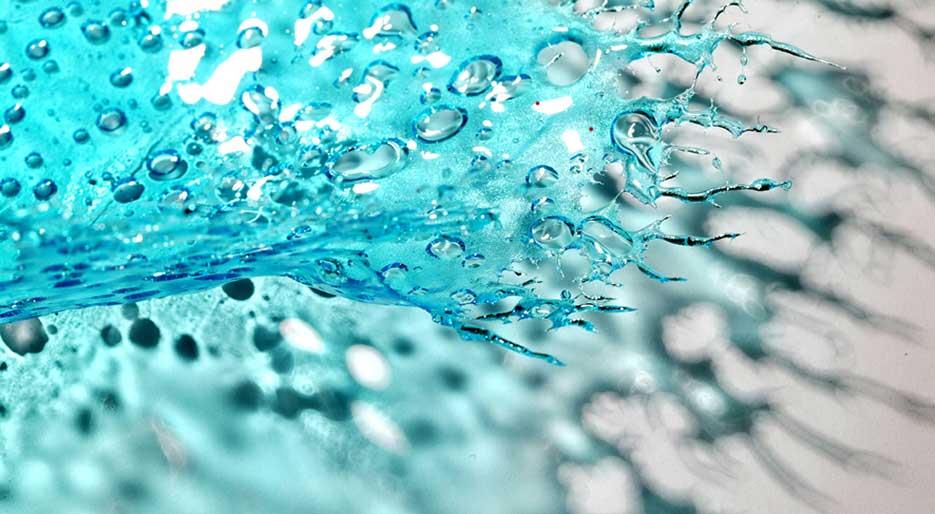
Rammohan Aluru and Grigoriy Zyryanov ones on scientists group, who have developed edible food films based on seaweed (stripped off solution of ferulic acid and sodium alginate in a Petri dish).
CREDIT: UrFU / Andrey Fomin
Films consist of natural ingredients, they are healthy-safe and water-solubility
An international group of scientists from India and Russia has created edible food films for packaging fruits, vegetables, poultry, meat, and seafood. Films consist of natural ingredients, they are safe for health and the environment. In addition, films are water-soluble and dissolve by almost 90% in 24 hours. Description of the research and results of experiments are published in the Journal of Food Engineering.
“We have created three types of food films based on the well-known naturally occurring seaweed biopolymer sodium alginate,” said Rammohan Aluru, senior researcher Organic synthesis laboratory at Ural Federal University and co-author of the paper. “Its molecules have film-forming properties. Sodium alginate is an auspicious carbohydrate macromolecule that has the potential film-forming properties upon hydrolysis and abundantly existed in cell walls as a mixture of various salts. The greatest advantage of sodium alginate is that it performs as liquid-gel in an aqueous medium.”
Alginate molecules were cross-linked with a natural antioxidant ferulic acid. It makes the film not only strong, but also homogeneous, more rigid, and prolongs the life of the products.
“Food stays fresh longer due to the antioxidant components that slow down the oxidation processes,” said Grigory Zyryanov, professor of the Department of Organic and Biomolecular Chemistry at Ural Federal University. “In addition, we can add to the films natural antiviral agents, that will also extend the shelf life of food. Garlic, turmeric, and ginger contain compounds that may prevent the spread of the viruses.”
According to the authors, no special equipment for the production of films is required. On an industrial scale, it can be created by food products and films manufacturers.
“It can also be produced at a polymer production plant. The only condition is that it must meet the standards that apply to food production. And if an inexhaustible source of algae the ocean is nearby it will be quite simple to create such films,” said Grigory Zyryanov.
Original Article: Scientists created edible food films for food packaging
More from: Ural Federal University
The Latest Updates from Bing News & Google News
Go deeper with Bing News on:
Edible food films
- 10 movies that will ruin your appetite
Hopefully, nobody watches a movie with the express intention of having their dinner plans sabotaged, but sometimes it can be unavoidable.
- Varsity student films herself eating mouldy bread while studying, video shocks the internet
See a university student consuming mouldy bread while studying. The shocking video has South Africans buzzing about the lengths some will go for online fame.
- Turns Out, the Basic Recipe for Fake Blood Hasn’t Changed Much Since the ’70s
The fake blood recipe used in movies hasn't changed much since 'Taxie Driver' but offers plenty of variations for shoots. Vegan blood, anyone?
- What to Watch When You Get the Munchies on 4/20
While some people could get giggly and others might start feeling sleepy, many people will find themselves getting a major case of the munchies. Luckily, we’ve got some suggestions for how to pass the ...
- Global Protein Films Market Poised for Remarkable Growth, Forecasted to Reach US$ 2.2 Billion by 2032
The global protein films market is set to experience a significant surge, reaching a valuation of US$ 2.2 Billion by 2032, with a Compound Annual Growth Rate (CAGR) of 5.9%. This projection marks a ...
Go deeper with Google Headlines on:
Edible food films
[google_news title=”” keyword=”edible food films” num_posts=”5″ blurb_length=”0″ show_thumb=”left”]
Go deeper with Bing News on:
Edible food films for food packaging
- A moon shot to replace plastic wrap
If it seems like plastic surrounds nearly every cucumber, apple and pepper in the produce aisle, it does. What began with cellophane in the ...
- 9936 chemicals found in plastic products used for food packaging
Many of the chemicals identified in plastic food packaging are not just passive elements; they actively disrupt crucial bodily functions.
- 53 Interesting Photos of Cool Things You Don’t See Every Day
While we don’t pay too much attention to the noodles before throwing them in the boiling water, we’re pretty sure we would’ve noticed if a few of them were intertwined. Check this out! These spaghetti ...
- Global Protein Films Market Poised for Remarkable Growth, Forecasted to Reach US$ 2.2 Billion by 2032
The global protein films market is set to experience a significant surge, reaching a valuation of US$ 2.2 Billion by 2032, with a Compound Annual Growth Rate (CAGR) of 5.9%. This projection marks a ...
- This must be Topanga Canyon
After a particularly rainy season, multiple mudslides have blocked Topanga Canyon’s entry from PCH for more than a month. Shops, restaurants and other businesses that depend on visitors are struggling ...
Go deeper with Google Headlines on:
Edible food films for food packaging
[google_news title=”” keyword=”edible food films for food packaging” num_posts=”5″ blurb_length=”0″ show_thumb=”left”]







